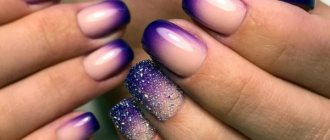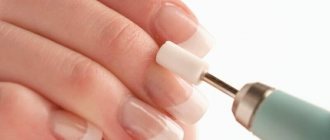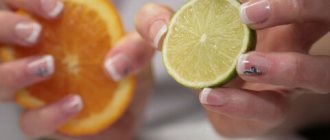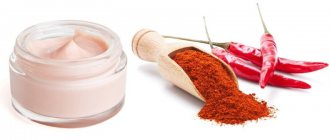Features of the nail shape
The trapezoidal shape of nails is quite rare, so not even all nail technicians know how to work with it correctly so that the manicure looks neat and feminine.
There are quite a lot of features in working with such nails, failure to comply with which can ruin the visual effect, making the manicure awkward and sloppy.
Key features to consider when working with a wide plate:
- To visually make the nail narrow and long, you should push back the cuticle and always monitor its condition, since growths of keratinized epidermis on the bed always reduce its length;
- It is recommended to choose a shape with rounded corners - oval or almond. A strict square will only ruin the manicure;
- For decorative coatings, it is recommended to use dark shades;
- Long, wide nails will always look neater than short ones, since the length visually compensates for their original size;
- When choosing a design, it is recommended to apply minimalist designs or patterns (without touching the side parts of the nail, but placing them in the center).
You should also be careful in choosing the design that you plan to implement on a wide manicure. Not all basic and classic options will suit you.
The design will look sloppy:
- French manicure (with a short plate length). A thin line in the free zone will only emphasize the width of the nail.
- Acid colors. Even in summer, you can’t use bright colors that will immediately catch your eye.
- Large drawings. They can also highlight how wide the girl's plate is.
- Gradient. A horizontal transition of shades will also look out of place.
You need to be careful with floral designs, as any size can ruin your manicure.
Leveling with base coat
One of the most common methods is to level the nail plate with a rubber base. The material used is thick, since the ease of application and the quality of the work performed directly depend on it. Materials that are not thick enough do not have time to be fixed in the required place and flow down to the lateral rollers.
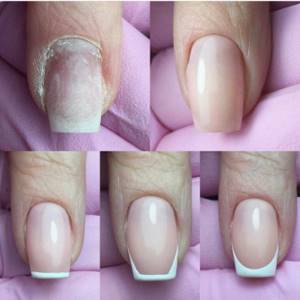
Main application steps
- cleansing, degreasing and dehydration of the nail plate;
- using a brush, pick up the required amount of material and apply in a small layer;
- apply the required amount of material at the highest point of the nail, stretch it to the base, and then stretch it in three steps along the center and along the edges;
- use a brush to form the required shape of the nail plate;
- turn the nail over, seal the end and cure thoroughly in a lamp.
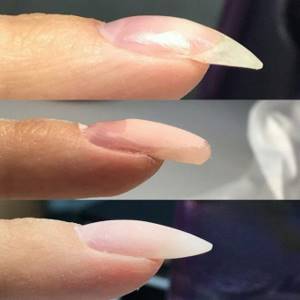
How to fix it at home
Proper correction of a wide nail can make a manicure neat and feminine, but for this you need to pay attention to the peculiarities of the technique.
As a standard, you should find out the reason why the nail bed is wide. This is not always due to the girl’s genetic predisposition; sometimes the defect occurs due to the habit of biting nails, then it will have to be eliminated.
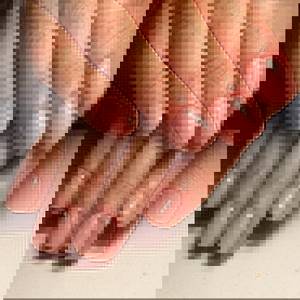
First, treat your hands and the tools you use with an antiseptic, and then you can start:
- Adjust the shape of the free edge with a file. Sharp corners should not be left, but from the beginning of the free edge (without touching the nail bed itself), eliminate the widening of the surface.
- Apply the remover to the cuticle.
- After a minute, use an orange stick or a metal pusher to move away the keratinized epidermis and lift its regrown part.
- Cut the cuticle with nippers or nail scissors; its base should be pushed back as far as possible and pressed against the nail.
- Use buff to polish the surface, removing uneven surfaces and cosmetic defects.
It is not recommended to cut down the length of the free edge too much, since the nails in this state will look wider.
After finishing the cuticle treatment, apply its essential oil or rich nourishing cream to prevent the rapid growth of the epidermis on the nail.
It is recommended to perform a basic manicure every 1.5-2 weeks, depending on the rate of nail growth. When performing gel polish, correction is usually carried out after 3 weeks.
Basics of nail plate alignment
Absolutely all people have different types of nails in structure. Only a few can boast of impeccable form.
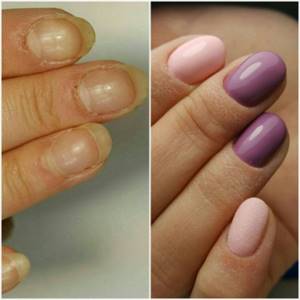
When applying various coatings to the nail, the nails are constantly subjected to various treatments - filing, grinding, removing the coating and other types of work that additionally negatively affect the general condition of the nails.
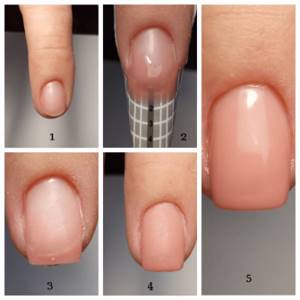
Therefore, more and more representatives of the fair sex want to learn how to straighten the nail plate.
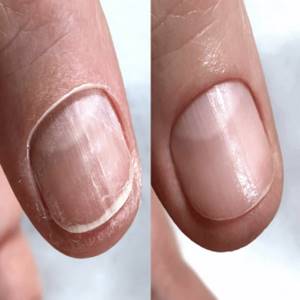
Alignment of the nail plate is required for a number of reasons:
- nails become stronger and denser;
- alignment allows you to get rid of any nail defects;
- When applied, the material lays more evenly, and the nails look flawless;
- manicure lasts much longer;
- for future treatments and removal of the coating, there is no need to file down to the base of the nail.
Extensions for wide nails
To make wide nails look neat, it is recommended to wear them with a long free edge, but not all manicures are predisposed to growing in length, which is why girls often resort to extensions.
Extensions are an effective procedure for eliminating wide nail beds, but be careful when doing it so that the work looks organic and natural.
Extensions can be done using forms or tips, depending on your convenience. And acrylic gel is used as a basis for extending the plate due to its increased strength and wear resistance. However, keep in mind that frequent use of acrylic in manicure gradually thins the surface.
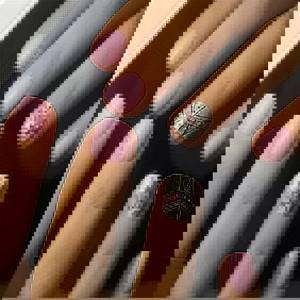
However, wide-based extensions have several features that should be taken into account:
- A wide nail is an excellent basis for fixing artificial turf. The work will remain in the same condition for a long time;
- When performing extensions, make sure that the shape of the plate is perfectly even, since the tips bent down will only spoil the condition of the nails;
- The extension will look natural if the length of the free edge does not exceed the size of the nail. Standard wide nails are quite short, so it is not recommended to make the work too long;
- Gel polish leaking to the side rollers is the main enemy of corrective extensions, since they will only highlight the width of the nail bed, emphasizing the girl’s original problem. It is better to apply several layers of decorative coating than one thick one that will spread over the surface.
To prevent the width of the nail bed from being noticeable, many women resort to extensions, but when doing it, be careful - the result of the work does not always look natural.
Leveling with biogel
Biogel is rightfully considered an equally popular material for correction. There are varieties of it designed for thin and weakened nails. Artists usually use a soft brush with a rounded shape.
Before leveling with biogel, you must apply a base coat.
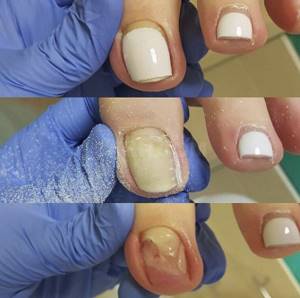
Main stages of application:
- thorough cleansing, grinding and degreasing of the nail plate;
- Using a brush, you need to apply the first layer of base biogel;
- gently rub the base over the entire area of the nail plate, without missing a single section, and seal the end;
- polymerize the applied layer in a lamp (biogel drying time is identical to gel polish);
- when applying the next layer, a brush is also used, with which you need to collect the required amount of material;
- the material is applied in the center of the nail, almost at the very base, and drawn with a brush to the cuticle;
- after this, you need to pull the gel down to the base of the nail plate;
- Next, you need to distribute the gel over the nail, not reaching the edge, in order to avoid contact with the sticky layer and not damage its integrity;
- These actions must be performed without pressing the brush, for a more even distribution of the material over the nail plate;
- it is necessary to treat the side zones;
- To complete the application, it is necessary to seal the end of the nail plate and dry the last applied layer.

Experienced nail specialists always remove the dispersion layer before applying color coating. This action is carried out even if subsequently no colored gel polish is used. After this procedure, the color layer will be applied more evenly.
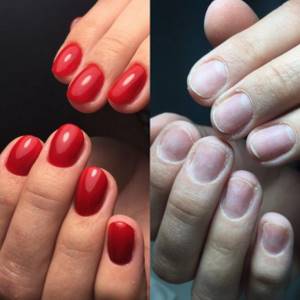
Decor
When choosing jewelry, you should adhere to basic rules that will protect you from mistakes.
Professional secrets of leading masters will help you with this:
- If the choice fell on a small pattern of numerous details, then limit yourself to the design of only one or two fingers.
- Avoid horizontal stripes forever - they visually “cut” your nails and distort their natural appearance. Transverse lines are only allowed in French jackets.
- The coating of flashy neon pigments attracts unnecessary attention and creates bulky volume, which looks ridiculous on hands with a similar structure.
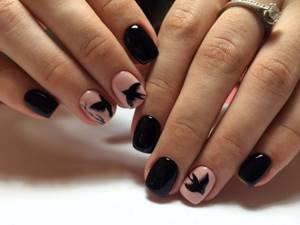
Try using a stencil of self-adhesive tapes and make a “striped” print. It perfectly changes the shape of the plate.

